Luis de Moscoso Alvarado facts for kids
Quick facts for kids
Luis de Moscoso Alvarado
|
|
|---|---|
| Born | 1505 |
| Died | 1551 (aged 45–46) |
| Nationality | Spanish |
| Occupation | explorer and conquistador |
Luis de Moscoso Alvarado (born in 1505, died in 1551) was a Spanish explorer. He was also a conquistador, which means he was a leader in the Spanish efforts to explore and claim new lands in the Americas. Luis de Moscoso Alvarado became the leader of Hernando de Soto's expedition after de Soto passed away.
Who Was Luis de Moscoso Alvarado?
Luis de Moscoso Alvarado was an important figure in the early exploration of the Americas. He helped Spain claim new territories. His journeys took him through parts of what are now Mexico, Central America, and the southern United States. He is remembered for leading a challenging expedition across North America.
Early Life and Family
Luis de Moscoso Alvarado was born in Badajoz, Spain, in 1505. His parents were Alonso Hernández Diosdado Mosquera de Moscoso and Isabel de Alvarado. He had two brothers, Juan de Alvarado and Cristóbal de Mosquera. His uncle was the famous Spanish conquistador Pedro de Alvarado. Pedro de Alvarado was well-known for his role in the Spanish conquests of Mexico and Central America. This family connection likely influenced Luis's own path as an explorer.
Exploring with His Uncle, Pedro de Alvarado
Luis de Moscoso Alvarado joined his uncle, Pedro de Alvarado, on several expeditions. These journeys took them to the Americas. He helped in the Spanish efforts to claim lands in what is now Mexico, Guatemala, and El Salvador.
Founding San Miguel
In 1530, Pedro de Alvarado sent Luis to an area in eastern El Salvador. His mission was to establish a new Spanish settlement. On May 8, 1530, Luis de Moscoso Alvarado founded the town of San Miguel de la Frontera. This town is located in what is now the San Miguel Department. He established San Miguel with about 120 Spanish cavalry and infantry. They also had help from local allies.
Later, in 1534, Luis traveled to Peru with his uncle. They explored parts of what is now Ecuador. During this expedition, they encountered various local tribes in the Manabí Province.
Joining Hernando de Soto's Expedition
After his time in Peru, Luis de Moscoso Alvarado and his two brothers decided to join another Spanish explorer. They teamed up with Hernando de Soto. De Soto and Alvarado returned to Spain in 1536.
On April 7, 1538, de Soto's large army set sail for Florida from Sanlucar de Barrameda, Spain. They traveled via Cuba. Luis de Moscoso Alvarado was a key leader, commanding one of the expedition's seven ships.
On May 10, 1539, the expedition landed in what is believed to be the Tampa Bay area of Florida today. Alvarado was given the important title of "maestre de campo" (field commander). This meant he was in charge of the army's movements and organization.
Challenges in Florida and the Mississippi Region
The expedition faced many challenges. In March 1541, the group had a difficult encounter with the Chickasaw Native American tribe. This event, likely due to a misunderstanding, resulted in losses for the expedition.
On May 21, 1542, Hernando de Soto passed away from a fever in what is now Arkansas. Luis de Moscoso Alvarado then took over as the leader of the expedition. After discussing with the other leaders, Moscoso decided to change their plans. They would no longer try to establish a colony. Instead, they would try to reach New Spain (present-day Mexico).
Leading the Expedition to Mexico
Moscoso and his group marched west. They traveled through what is now northwest Louisiana and Texas. Along the way, they met Caddoan Mississippian peoples. However, they struggled to communicate due to a lack of interpreters. The land also became very dry, making it hard to find food. The expedition eventually turned back towards the Mississippi River at a place called Guachoya.
Building Boats and Reaching the Gulf Coast
During the winter of 1542–1543, the survivors worked hard. They built seven small ships called "bergantines" or "pinnaces." Their goal was to find a water route to Mexico.
On July 2, 1543, just over half of the original expedition members (322 people) were still alive. They began their journey down the Mississippi River. They faced further challenges and difficult encounters with local groups, leading to more losses.
Alvarado's group finally reached the Gulf Coast on July 16, 1543. From there, they sailed westward along the coasts of Louisiana and Texas. They likely explored some of Texas's bays, such as Matagorda Bay or Corpus Christi Bay. Eventually, they arrived at the Pánuco River and continued on to Mexico City.
Later Life and Legacy
In Mexico City, Moscoso wrote two letters to Charles V. Charles V was the king of Castile at that time. These letters provided some details about the expedition.
Later, Moscoso began working for the viceroy of New Spain, Antonio de Mendoza. He traveled with Mendoza to Peru in 1550. Luis de Moscoso Alvarado passed away in Peru in 1551.
Personal Details
After his return and sending letters to the King of Spain, Luis de Moscoso Alvarado married his cousin, Leonor. Leonor was the daughter of Juan de Alvarado, who was also an uncle to Luis and brother of Pedro de Alvarado. They were married in Mexico City.
See also
 In Spanish: Luis de Moscoso para niños
In Spanish: Luis de Moscoso para niños


